Have you considered Facebook Promoted Posts? Examples of results from tests.
Another new feature that Facebook is offering (and yet more evidence of its post IPO drive to monetise) is Promoted Posts.
As I reported here recently, most fans are only seeing 17% of a brand's posts. This data has always been available in the Insights dashboard, but Facebook are now choosing to bring it to brand page admin's attention far more by displaying the percentage to date under each post.
Brand page managers have been less than delighted to discover that they are now having to pay for the privilege of their earned fans seeing their updates. But, even with the best optimised posts on the platform, you will be limited in getting your message out there. Enter Promoted Posts.
It's pretty simple to promote a post. Create your new post and either at that point (or up to three days later) selecte "Promote". Depending on your fan base size you'll be offered a range of pricing options. My page is just over 3,000 fans and I'm currently being offered prices from $5 to $20.
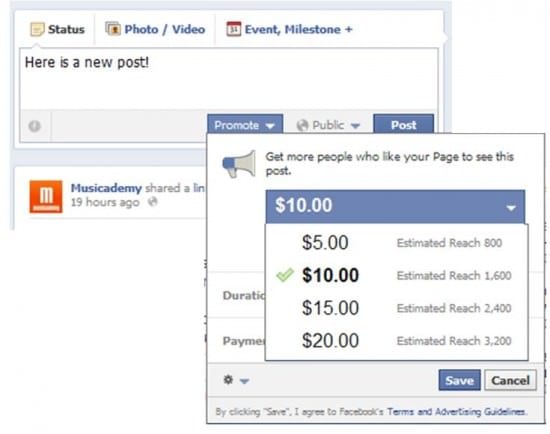
So what effects are promoted posts having? I've not scientifically tested this yet, but you can see an average non promoted post vs two promoted posts below.
The first post is a typical Musicademy post. The topic is of interest to a fair degree of our audience and we've chosen a relevant photo combined with a comment and link back to our website. This is not promoted and has enjoyed a 27% reach. Pretty good in comparison to Facebook averages for non promoted posts. Helped, I imagine by the fact that our page is highly engaged and there were a good number of likes, comments and a share
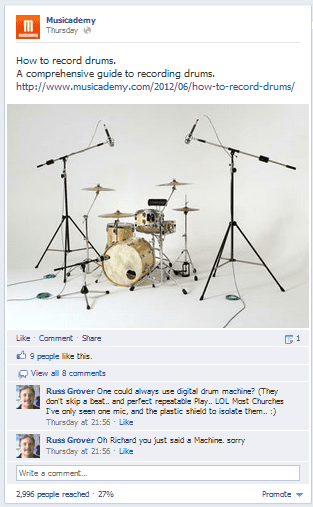 Still, I'm fascinated by the potential this promo from Facebook to marketers suggests:
Still, I'm fascinated by the potential this promo from Facebook to marketers suggests:
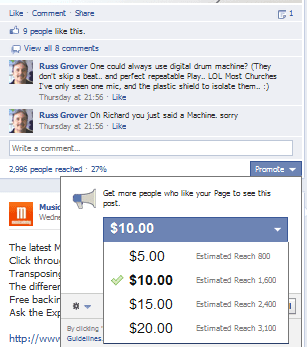
According to Facebook's sales blurb here, a promoted post costing $15 would get me a reach of 2,400. Well I've managed that myself, thank you very much, and am nearly at the $20 level! This really isn't very convincing. I wonder if perhaps the estimated number figures are devised at the time of initial posting and don't take into account the natural virality of the post when you go back a couple of days later to consider an additional boost via promotion.
An example of testing Facebook Promoted Posts
The next post example below is a test promoted post where I paid $10. This has hit 44% of my fanbase so appears to have been a reasonable investment. You can't split test of course, so you'll need to test with a variety of posts over time and look at the general success curve. And of course this also raises the question as to what an acceptable ROI is. Is it good enough that more people have seen it? Does it need to drive sales? Would it be better to invest that budget in advertising instead?
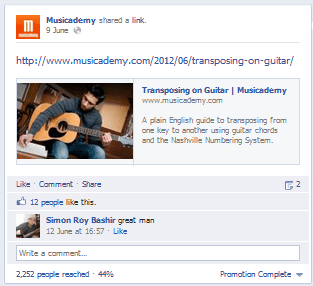
The next post example below is an interesting one. It's one of those rare pieces that has really gone viral for us. At the time of clipping this, the post had enjoyed 1,394 likes, 2,079 shares and 279 comments. It, together with another hysterically funny post (go on - click through - you won't be disappointed), we published last week has resulted in stratospheric page engagement rates. We're currently rocking a 178% page engagement rate (a recent study of Facebooks top 200 brands showed that on average only 1% of fans are engaging with brands). So for this week we are (according to one metric at least) one of the most successful pages on the platform.
This means that there are more People Talking About This (Facebook's PTAT metric) than we actually have fans due to the virality of the content. This accounts for the PTAT score being over 100%. Despite this post clearly being (proportionately) one of the most liked items on Facebook this week, Facebook has only presented it to 33% of our fans, and that was with us paying $5 to promote the post.
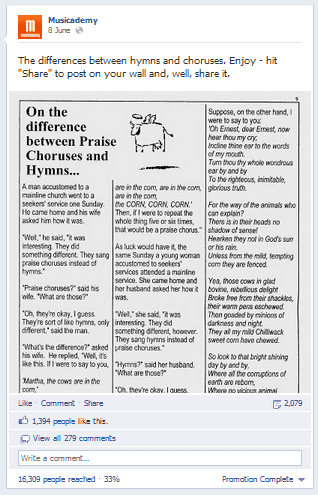 I hope you find these tests inspire you to consider promoted posts or maybe just change the type of posts you use. Do share your findings too.
I hope you find these tests inspire you to consider promoted posts or maybe just change the type of posts you use. Do share your findings too.











